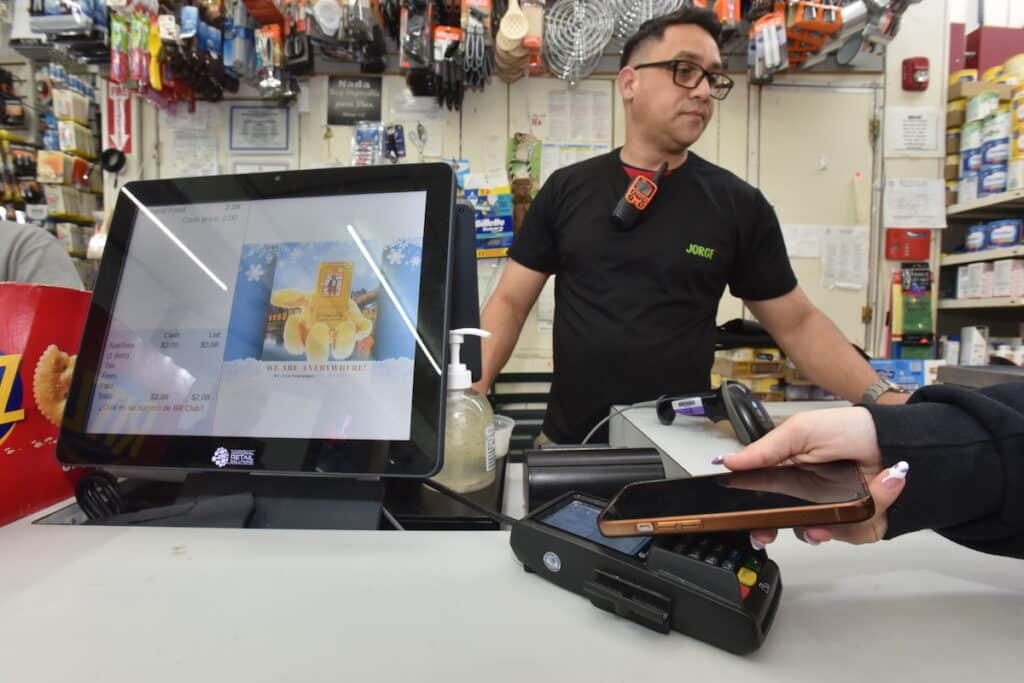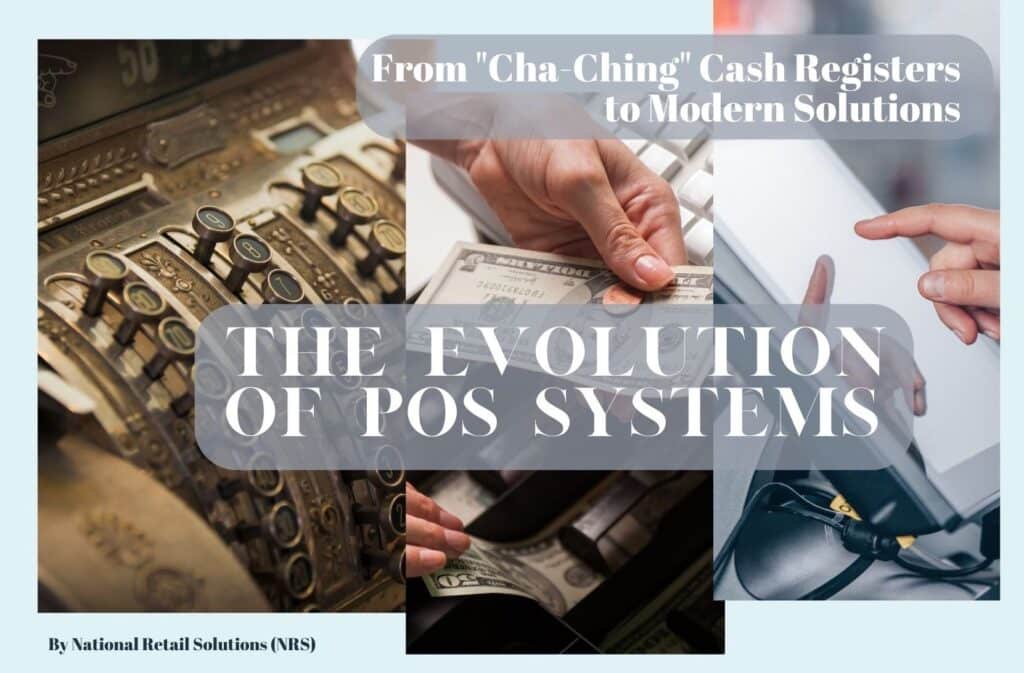A Revolution in Retail: The Evolution of POS Systems
From combating employee theft in 19th-century saloons to predicting what you’ll buy next, the evolution of POS systems is a story of problem-solving and groundbreaking innovation.
Today, point of sale (POS) systems do more than just accept payments. They manage inventory, track customer data, and provide valuable insights to help businesses grow. But how did we get here?
Let’s look at the fascinating history of the evolution od POS systems and how they’ve evolved.
The Birth of Cash Registers and the Iconic “Cha-Ching” Sound

In 1879, James Ritty, a saloon owner from Dayton, Ohio, invented the first mechanical cash register. He called it the “Incorruptible Cashier.” Ritty was tired of his employees stealing money from the cash drawer. He needed a way to keep track of sales and prevent theft.
Ritty’s invention solved a big problem for business owners. It made it easier to record sales and keep money safe. The “Incorruptible Cashier” had a dial on the front showing each sale amount. It also had a bell with the now iconic “cha-ching” rang whenever the cash drawer opened, letting the owner know when money was being put in or taken out.
The first cash registers were simple but effective. They had a few key features:
- A dial to show the amount of each sale
- A bell that rang “cha-ching” when the cash drawer opened
- A paper roll to record sales
- Separate compartments in the cash drawer for different types of coins and bills
These early machines laid the foundation for today’s modern POS systems.
The Emergence of Electronic Cash Registers (ECRs)

In the 1970s, cash registers went from mechanical to electronic. This was a significant technological leap. Electronic cash registers (ECRs) had many advantages over their mechanical predecessors:
- Digital displays made it easier for cashiers to read and enter prices
- Barcode scanners sped up the checkout process and improved accuracy
- Built-in memory allowed for basic sales tracking and reporting
These new features allowed businesses to ring up sales faster and more accurately and analyze their sales data to make better decisions.
Introduction of Point of Sale (POS) Systems
Key Takeaways:
- POS systems are complete business management tools, not just cash registers
- In the 1980s and 1990s, early POS systems ran on personal computers with integrated software
- POS systems provide more integration than “smart” cash registers, tying together sales, inventory, and customer data
POS systems are more than cash registers. They are complete business management tools. A point of sale system typically includes hardware like a computer, monitor, cash drawer, receipt printer, and barcode scanner, but the real power is in the software.
Early POS systems in the 1980s and 1990s were based on personal computers. They ran software that could do much more than a traditional cash register. These systems could track inventory, manage customer data, and generate detailed sales reports.
The key difference between early POS systems and “smart” cash registers was the level of integration. Smart cash registers could do basic sales tracking and reporting, but POS systems tied all aspects of the business together. They could track sales, inventory, and customer data in one place, giving business owners a complete picture of their operations.
Features and Functionality of Early Systems
The first computerized point-of-sale solutions offered a range of features beyond simple transaction processing. While less advanced than today’s technology, they provided businesses valuable tools to manage their operations more efficiently.
- Inventory Management:
- Basic stock tracking capabilities allowed businesses to monitor their inventory levels
- Some systems could generate reordering alerts when stock ran low, helping to prevent stockouts
- Sales Reporting:
- Shift-level reports provided insights into sales performance throughout the day
- Basic product performance reports helped identify top-selling items and underperforming products
- Employee Management:
- Some early solutions included basic employee management features, such as clock-in/out functionality
- Sales data could be linked to individual employees, allowing for performance tracking and commission calculations
- Limited Integrations:
- Some early systems offered basic integrations with accounting software
- This allowed for easier transfer of sales data into the business’s financial records, reducing manual data entry
The Rise of Integrated POS Solutions
As technology advanced, so did the capabilities of point of sale systems. One of the most significant developments was the rise of integrated solutions. These systems connected various business functions, allowing seamless data flow and improved efficiency.
Integration between the point of sale and other business functions brought numerous benefits:
- Accounting software integrations:
- Sales data could be automatically transferred to accounting software
- This eliminated the need for manual data entry, saving time and reducing errors
- Real-time financial reporting became possible, giving businesses a clearer picture of their financial health
- The emergence of CRM functionality:
- Integrated systems began to incorporate customer relationship management (CRM) features
- This allowed businesses to track customer purchase histories, preferences, and contact information
- Targeted marketing campaigns and loyalty programs became easier to implement and manage
The rise of integrated solutions marked a significant shift in the role of point-of-sale systems. They evolved from simple transaction processing tools to comprehensive business management platforms, which laid the foundation for the advanced, data-driven systems we see today.
Advancements in POS Technology
As technology progressed, point of sale systems became more sophisticated and user-friendly. These advancements made it easier for businesses to operate efficiently and better serve their customers.
- Touch Screen Interfaces:
- Intuitive touch screens made it easier for employees to learn and use the system
- User-friendly interfaces reduced training time and increased accuracy
- Customizable layouts allowed businesses to tailor the interface to their specific needs
- Cloud-Based POS:
- Cloud technology allows for remote access to the system from anywhere with an internet connection
- Data was securely stored in the cloud, reducing the risk of loss due to hardware failure
- Less on-site hardware was needed, saving businesses money on equipment and maintenance
- Mobile POS:
- Tablets and smartphones enabled businesses to take the checkout process to the customer
- Mobile systems made it easier to serve customers in different parts of the store or at events
- Flexibility to process transactions anywhere improved the customer experience and increased sales
Modern POS Solutions: Beyond Transactions
Today’s point of sale systems are powerful tools for businesses to manage customer relationships, streamline operations, and make data-driven decisions.
- CRM features help build customer loyalty and enable targeted marketing
- Omnichannel retailing integrates online and in-store sales, inventory, and fulfillment
- Advanced analytics and reporting provide insights for data-driven decision-making
- Industry-specific features like reservations, table management, and appointment scheduling are available
Challenges and Future Trends
As point of sale technology evolves, businesses must navigate new challenges and stay ahead of emerging trends. Data security, artificial intelligence, POS-integrated panic alarms, contactless payments, and customer experience are key areas that will shape the future of POS systems.
- Security remains a top priority as cyber threats become more sophisticated
- AI will play a bigger role in predictive analytics and personalized recommendations
- Contactless payment options will be essential in a post-pandemic world
- POS systems will be crucial in delivering seamless, personalized customer experiences


